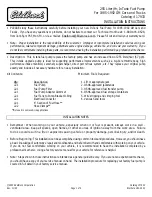
When driving on an incline, drive into the line
of fall (upwards or downwards in a straight
line) and do not turn.
Always observe the approach/departure angle
values (
Y
page 255).
R
Observe the safety notes (
Y
page 119) and
general notes (
Y
page 119) on driving off-
road.
R
Follow the line of fall when driving on slopes
and steep inclines.
R
Before driving on extreme uphill and extreme
downhill gradients, set the transfer case to
the LOW RANGE off-road driving position
(
Y
page 124).
R
Engage the differential locks if necessary
(
Y
page 126).
R
Drive slowly.
R
Accelerate gently and make sure that the
wheels are gripping.
R
Avoid high engine speeds, except when driv-
ing on sandy and muddy routes with high driv-
ing resistance.
R
Use the braking power of the engine when
driving down a slope. Observe the engine
speed; do not overrev the engine.
R
Shift the automatic transmission to a low gear
appropriate for tackling an uphill gradient or a
long, steep downhill gradient.
The HOLD function assists you when pulling
away and manoeuvring on a slope or hillside
(
Y
page 122).
Maximum gradient-climbing capability
Always observe the maximum gradient climbing
ability values (
Y
page 255).
Hilltops
When driving up an uphill gradient, slightly
reduce pressure on the accelerator immediately
before reaching the brow of the hill. Make use of
the vehicle's own impetus to travel over the
brow.
This style of driving prevents:
R
the vehicle from lifting off the ground on the
brow of a hill
R
loss of traction
R
the vehicle from travelling too quickly down
the other side
Driving downhill
R
Drive slowly.
R
Do not drive at an angle down steep inclines.
Steer into the line of fall and drive with the
front wheels aligned straight forwards. Oth-
erwise, the vehicle could slip sideways, tip
and overturn.
R
Before tackling steep downhill gradients, shift
the automatic transmission to a low gear.
By doing so, you will use the braking effect of
the engine to reduce the speed. If this is not
sufficient, brake gently. When doing so, make
sure that the vehicle is facing in the direction
of the line of fall.
R
Observe the notes on driving in mountainous
terrain (
Y
page 122).
R
Check that the service brake is working nor-
mally after a long downhill stretch.
When driving at speeds below 60 km/h, off-road
ABS is activated and the front wheels lock cycli-
cally during braking. The digging-in effect ach-
ieved in the process reduces the stopping dis-
tance during off-road driving. This limits steering
capability.
Driving systems
HOLD function
General notes
The HOLD function can assist the driver in the
following situations:
R
when pulling away, especially on steep slopes
R
when manoeuvring on steep slopes
R
when waiting in traffic
The vehicle is kept stationary without the driver
having to depress the brake pedal.
The braking effect is cancelled and the HOLD
function deactivated when you depress the
accelerator pedal to pull away.
Do not use the HOLD function when driving off-
road, on steep uphill or downhill gradients or on
slippery or loose surfaces. The HOLD function
cannot hold the vehicle on such surfaces.
122
Driving systems
Driving
and
parking
















































